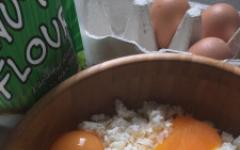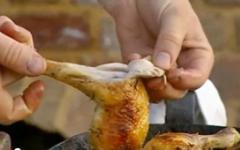Achatina are giant snails, one of the largest among mollusks. The homeland of these creatures is Africa. Currently, snails are widespread throughout the world. In Asian and African countries they are considered pests, as the mollusks destroy reed crops. And in Russia they are kept on special farms and at home. The benefits and harms of Achatina snails are well known to cosmetologists. The secretion secreted by these creatures has beneficial properties.
What does the Achatina snail look like?
The snail Achatina fulica belongs to the class of gastropods and in its natural habitat is found only in regions with a tropical climate. The maximum dimensions can reach 30 cm in length, and weight - 500 g. True, most representatives of the species cannot boast of such parameters. Individuals kept as pets most often weigh 100–200 g.
Snails have large cone-shaped shells that curl in different directions. Moreover, the number of turns depends on age: the older Achatina is, the more turns there are on its shell. At the anterior end of the body there are several pairs of tentacles of varying lengths.
These creatures are interesting because they are hermaphrodites, that is, they have both male and female organs and can self-fertilize. Snails lay eggs every few months. Each clutch contains up to 300 eggs.
Types of snails Achatina
There are about a hundred species of giant snails in nature. Among the most common and useful species for humans, which are most often kept as pets, are Achatina fulica and Achatina reticulata. Their features:
- Snail Achatina fulica It is distinguished by the variegated color of its shell, which can change shades depending on its feeding habits. The soft body is colored brown and brown and has noticeable bumps on the skin. These useful creatures are very slow, prefer a quiet rest in secluded corners, and caring for them is very easy.
- Snail Achatina reticulata more mobile and active, often tries to look at what is happening around her, raising her head. It has a beautiful shell decorated with a pattern of dots and stripes. The soft body is dark brown or black.
Composition of Achatina snail mucus
Distinguished by its beneficial properties, snail mucus is a translucent viscous liquid. Gastropods need it in order to protect the sole from friction and facilitate the process of movement. In addition, the benefit of Achatina snail mucus in cosmetology is that it acts as a wound healing agent. The substances included in its composition are capable of restoring damaged snail shells.
Snail secretion includes useful components:
- Collagen is a healthy protein that preserves the natural elasticity and firmness of the dermis.
- Allantoin is an antioxidant that fights free radicals and activates regenerative processes. Snails need allantoin to protect and repair their shells.
- Elastin. The Achatina snail, whose mucus includes elastin, is beneficial to the skin in maintaining the smoothness and elasticity of the dermis.
- Vitamins A, B, E, C.
- Peptides. Serve as protection against bacteria that can cause skin diseases.
- Glycolic acid. Necessary for cleansing the dermis of dead cells and impurities.
- Lectins are natural cleansers.
Useful properties of Achatina snails
The Achatina snail has served humans for hundreds of years. The use of mucus allows you to:
- rejuvenate the skin;
- reduce expression wrinkles, including around the eyes;
- get rid of skin diseases;
- moisturize and regenerate the skin;
- lighten pigmentation;
- treat scars.

The benefits and harms of Achatina snails were assessed by cosmetologists. Antibacterial snail mucus does not cause harm to human skin, as it is hypoallergenic, and therefore its properties are effectively used in the production of cosmetics. At home, the substance is used for rejuvenation, and also as a traditional medicine against bronchitis and upper respiratory tract infections, to combat psoriasis and varicose veins. In addition, it has analgesic properties.
The meat of Achatina snails also brings benefits, the use of which helps eliminate problems of the gastrointestinal tract. And thanks to the potassium content, the product has the ability to relieve stress and normalize the nervous system.
How to use Achatina snails in cosmetology
African Achatina are the only species of giant snails that are used in cosmetology. The mucus of other mollusks does not have similar regenerating properties. It helps to cope with acne and inflammation, peeling and dryness, protect the skin from loss of elasticity and firmness, restoring them. In addition, thanks to the secretion of snails, you can smooth out wrinkles, tighten enlarged pores, and fight age spots.
The basis of mucus is water and the protein mucin. Thanks to him, the benefits of Achatina in cosmetology are invaluable. This biologically active substance activates collagen synthesis in the skin and also eliminates toxic substances. In this case, not only the epidermis, but also the deep layers are exposed to mucin. Snail protein does not cause any harm to health.
Advice! For cosmetic purposes, you can use not only snail mucus, but also the eggs that remain after the snails emerge. The shell is a good way to cleanse the skin of the face and body.

Facial massage with Achatina
Particularly beneficial is massage of the body and face with Achatina snails. This procedure is usually performed in beauty salons. With its help, you can improve lymph flow, relax muscles, and restore skin elasticity.
Large specimens are selected for massage and at the same time peeling of the face with Achatina snails. Their soft bodies produce special wave-like movements that affect human skin, improving blood flow. The procedure does not cause harm, is hypoallergenic, and can be performed on patients with sensitive skin.
Before massage with Achatina snails, the human skin, as well as the body of the mollusk, is cleansed. Then they spread Achatina on the face so that it moves along the massage lines.
Sessions can last 10-30 minutes. The useful secretion secreted by the snails is left on the face for another 10-15 minutes. Then rinse off the skin and apply a cream containing mucin to consolidate the moisturizing and rejuvenating effect.
The number of procedures depends on the condition of the skin. If the purpose of snail massage is to eliminate skin problems, then 10-15 sessions are usually performed with an interval of 2 days. Rejuvenating massage is done once every 10-15 days to maintain the effect. At home, you can do it up to 3 times a week.
Important! In cosmetology, before and after sessions with Achatina snails, it is recommended to use products containing mucin.
Snail slime masks
Masks with snail mucin are used if the skin needs hydration and nutrition. Their beneficial properties are expressed in improving turgor, smoothing facial and deep wrinkles, lightening pigmentation, scars and stretch marks, healing wounds and burns. The products make the skin tighten, refresh the complexion and fight dark circles under the eyes. Cosmetologists advise adding other useful components to the snail secretion. Such compositions cannot cause harm, since they do not provoke the appearance of redness and rashes.

Banana tightening mask
Has moisturizing, nourishing, whitening properties. To prepare it you need:
- Take half a ripe banana and grind it to a puree.
- Add a teaspoon of snail mucus and half a teaspoon of sour cream. The fatter it is, the better.
- Mix the ingredients well.
- Clean your face, apply the mixture for 20 minutes, then rinse with warm milk. You can use this product once every 2 days.
Snail mask with vitamin E
To make such a mask yourself, you need:
- Collect 5 ml (1 tsp) snail mucin.
- Add a capsule of vitamins A and E, as well as 5 ml of warm milk.
- After mixing all the ingredients, add 1 tsp. corn starch.
- After cleansing the skin, apply the vitamin mixture to it and leave for 10-15 minutes.
- Rinse off with warm water.
The benefits of face masks with Achatina snail mucus include nourishing and tightening the skin, smoothing and improving color. You can resort to them no more than 2 times a week so as not to harm the epidermis.
Rejuvenating mask with oatmeal
The basis is oatmeal, ground in a coffee grinder. The mask recipe is simple:
- Pour the ground flakes into a warm decoction of string or chamomile (you will need 20 ml).
- Add 1 tsp. snail secretion.
- After mixing all the ingredients, carefully apply to problem areas: forehead, nasolabial triangle, around the eyes. Action time: 20 minutes.
- After this time, wash off the product. It is good to use warm water or herbal decoction.
The beneficial properties of the mask are indispensable for problem skin and the presence of deep wrinkles. 10-15 sessions can eliminate blackheads and pimples, tighten enlarged pores and improve facial contour. Can be applied daily.
How to collect mucus from a snail to make masks
Collecting snail mucus is a simple procedure that does not cause any harm to the mollusk. To do this you need to take a teaspoon. After touching the snail, so that its body activates the production of mucin, you need to carefully scrape it off the flat sole. Such actions do not cause pain to the snails. In 10-15 minutes you can collect up to a teaspoon of the substance. This volume is enough to prepare a mask.

Treatment with Achatina at home
The medicinal properties of Achatina snails have been valued since the time of Hippocrates. Their meat has long been used to treat anemia and other diseases. And mucus was used for burns and non-healing wounds. The benefits of giant snails are such that farms began to be created to grow them after World War II. Now shellfish are successfully used to combat cellulite, varicose veins, and psoriasis.
Achatina against cellulite
Thanks to the effect of snail secretions, the skin becomes smooth and clean. This property is used to combat cellulite. If you treat problem areas of the body correctly and do not exceed the permissible number of procedures, then they will not cause any harm.
Dealing with orange peel with snail mucin is easy. Visible effect can be achieved within one month. It is important to perform regularly, three times a week. He won't do any harm. During the procedures, snails are placed on a problem area, such as the stomach or thighs. The exposure continues for 15 minutes.
Achatina in the fight against varicose veins
The healing properties of massage help fight varicose veins. Before carrying out the procedure, thoroughly clean the areas that will be exposed. The snail is also washed under running water, after which it is placed on the body and allowed to move. After 10-15 minutes, the procedure is completed, and the remaining mucus is rubbed into the skin with massage movements for 15-20 minutes. The remains of the healing substance are washed off with water.

Treatment of psoriasis with snails
The beneficial effects of the substance secreted by snails on human skin are used to treat psoriasis. People who suffer from this disease are advised to keep these creatures as pets. While observing them, the nervous system relaxes and stressful conditions are alleviated. But the main benefit is the effect on rashes. Cosmetologists advise putting Achatina on them every day. Snail massage has the ability to relieve flaking and dryness and accelerate regenerative processes. For those who experience discomfort from touching snails, you can collect the substance they produce and rub it into the affected areas of the body.
Possible harm of Achatina and contraindications
The beneficial properties of Achatina are available to everyone who does not disdain these creatures. There are practically no contraindications for anti-aging and healing procedures. They can cause harm only if a person has an allergic reaction to the components of Achatina secretion. To avoid unpleasant consequences, apply a small amount to your wrist before using it. After 20-30 minutes, you need to check whether rashes or itching have appeared. If these signs of allergic reactions are absent, Achatina can be used without any harm to health. If irritation or redness occurs, you should consult a dermatologist about the advisability of such procedures.

How to grow Achatina at home
Domestic Achatina reaches a size of 25 cm. You should purchase them from trusted breeders or in specialized stores. To keep such a pet, a spacious terrarium is required. Its volume must be at least 20 liters.
The clam house must be provided with ventilation holes for air circulation, and also equipped with a food container and a lid to prevent the pet from walking around the house on its own.
The bottom of the terrarium should be covered with special soil. This is a necessary condition for growing Achatina, since snails sleep in it, use it for food, and lay eggs. Regular sand, sawdust or stones are not suitable. It is better to use moss, peat, coconut substrate.
How to care for Achatina
These exotic creatures do not require special care. It is enough to keep the terrarium clean by daily washing off dirt from its walls with hot water and changing the soil as necessary.
Important! It is not recommended to use cleaning products to wash the terrarium; this can cause harm to the Achatina.
Domestic snails need water treatments. It is advisable to equip their homes with shallow pools. And the pets themselves need to regularly have a warm shower. Holding the Achatina snail over the sink, it should be washed with a stream of water. The duration of the procedure is no more than 3 minutes.
The main components of the Achatina diet are lettuce, greens, vegetables, and cereal shoots. Gastropods can be fed carrots and cucumber pulp or tomatoes and zucchini, apples, pears, bananas, apricots, and other fruits. Soft food must be cut into pieces, and hard food must be grated or crushed in a blender. An important part of the Achatina diet is mineral supplements rich in calcium.

Important! Harm to Achatina snails can come from fried, spicy, salted, smoked foods, as well as fruits containing natural acids, including all citrus fruits.
The pet must be provided with clean water. Access to it must be constant, since gastropods drink it and take water procedures. A video of the Achatina snail demonstrates how important water is for this creature.
Conclusion
The benefits and harms of Achatina snails have been studied by cosmetologists and dermatologists. The appearance of mollusks is such that it is difficult for them to compete in attractiveness with other domestic animals. These terrarium inhabitants are more likely to be associated with alien creatures than with pets. The miraculous properties of Achatina mucin are such that at home they successfully replace expensive salon procedures.
A snail is any mollusk of the gastropod class that has an external shell.
Gastropods with a rudimentary shell or those that have completely lost it are called slugs. Since most gastropods have a shell, all members of the class are often called snails.
The body of the snail consists of a head, a leg and an internal sac, from which the mantle fold extends.
Snails move on the lower surface of the leg (sole), driving waves of muscle contractions along its length. In addition, the epithelium of the leg secretes a large amount of mucus, which promotes better gliding along the surface of the substrate.
Small snails are able to move by beating their cilia.
Snails live in small groups. At night, when it gets cool, they crawl out to feed. They eat almost everything: leaves, worms, small larvae of other forest inhabitants. And they search for food by touch, with their tentacle horns.
Snails see poorly; their small eyes are only able to distinguish day from night. But their sense of smell is very good.
For example, a slug - a snail without a shell - smells food even though it is two meters away from it.
Among the snails there are very tiny ones, 2-3 millimeters in size, and there are also giants: their houses are the size of three matchboxes stacked on top of each other. They are the ones that cause the most trouble to people.
On warm spring nights, snails go in search of their own kind to mate with. Having found each other, the future parents start a wedding. They spin around, touching each other with their tentacles. Sometimes this goes on for several hours.
Having finished courtship, the snails press tightly against each other and surround themselves with mucus so as not to fall apart during mating. At this time, each snail already contains 10-12 embryos. It's surprising, but most snails have neither males nor females. Each of them during mating is both the future father and the future mother.
The Greeks knew that snails were edible, tasty and nutritious even in ancient times. They decorated their holiday tables with them.
The ancient Romans kept snails in special snail gardens and fed snails taken from nature with aromatic herbs, especially thyme, which gave the snail meat a special aroma and taste. Snails fed with flour and wine before slaughter were served at the imperial table to expand the variety of meat dishes. An important role, obviously, was played by the fact that in addition to its excellent taste, Grape snail meat is also a fairly strong aphrodisiac.
Useful properties of snail
Snails are prepared in a very unusual way. They are collected from vineyards, cleansed their body (starved), lightly washed in water and transferred to a container filled with coarse salt, where they are left for two hours so that they release mucus. After this, the snails are lightly boiled and then stewed for about an hour in grape wine with butter, onions, tomatoes and spices, as an option. During the cooking process, snail meat absorbs all the flavors of the spices. The high content of vitamin B6 makes their protein meat easy to digest.
Grape snail meat contains 70% protein and 30% amino acids.
Snail mucus contains a significant amount of biologically active substances. Among them are amino acids, vitamins, alantoin, elastin, collagen, natural antibiotics in natural form, used by the snail to restore its damaged body, as well as its limestone house.
In Spain, France and Italy, the grape snail is eaten, and its taste is believed to be superior to that of other edible snails. Large snails are usually served in their own shells, seasoned with butter, garlic, onion and parsley.
Small ones are most often used to make sauces or stews, or added to soups; this is already the culinary art of the French.
Since ancient times, snails have been credited with the ability to cure various diseases. It is not for nothing that snails were considered a symbol of eternity in Babylon and Egypt. For some time, snail mucus as a remedy was undeservedly forgotten. However, in recent years, scientists have paid a lot of attention to the study of snail mucus.
The property of snail mucus to glue bacterial cells has found application in the treatment of diseases of the respiratory system, such as bronchitis, whooping cough and silicosis. In the old days, folk healers would sit a snail on a piece of sugar and, after it became covered in mucus, give it to someone who was sick with whooping cough.
Using its own mucus, the snail can completely rebuild its shell. Thanks to such powerful restorative properties, snail mucus has found wide use in cosmetology.
The mucus of common garden snails is included in many modern cosmetics, as it has strong antioxidant and antibacterial properties.
In addition, snail mucus has the unique property of creating a protective film that does not allow moisture to pass through, but at the same time allows air to pass through perfectly.
Snail mucus also has a powerful regenerating effect.
This was first noticed in shellfish factories. The workers who bred them had skin on their hands that resembled that of a child. Moreover, abrasions and scratches on the hands of breeders healed much faster than those of those who did not come into contact with mollusks. The regenerating properties of snail mucus are due to the content of allantoin, glycolic acid, collagen and elastin.
Balms and creams based on snail mucus effectively fight stretch marks, scars and acne.
Garden snail mucus does not cause an allergic reaction.
In their natural habitats, these snails are considered pests of agricultural crops. Despite the fact that Achatina snails cause harm to humans as a result of their vital activity, their benefits are also undeniable. Their mucus has a unique composition, namely, it contains large quantities of collagen, elastin, and glycolic acid.
The large African clam grows up to 35 centimeters in length and can weigh about 500 grams. This is the largest representative of mollusks. As a rule, the body weight of these individuals reaches 150-200 grams.
Also, this mollusk is a hermaphrodite, and eggs are laid every two months.
The cone-shaped shell twists in different directions and, depending on age, has a certain number of turns, and can also change color. Achatina has two pairs of tentacles. The mollusk has organs such as a heart, one kidney and a lung, a brain, and eyes at the tips of the tentacles. The respiratory function is carried out through the skin.
Life expectancy is on average 10 years. Also, this mollusk is a hermaphrodite, and eggs are laid every two months. In its natural habitat, there are up to one hundred varieties of Achatina, which do not have significant differences. In unfavorable conditions, they fall into suspended animation, lasting about a year.
Thanks to the properties of the secretion produced by snails, the sole is protected when moving and, in case of damage, it heals quickly.
It is this mucus that is considered medicinal and has value in cosmetology and folk medicine.
The secreted mucus contains:

The value of the substances that make up mucus lies in their naturalness and environmental friendliness.
Also, the secreted mucus has the properties of a solar filter - natural and safe.
Main contraindications and restrictions for use
The snail itself, like its mucus, does not cause allergic reactions, as it is hypoallergenic. Despite this, you should do a test for an allergic reaction. So, before the procedure, you need to place Achatina on your wrist for a few minutes. If there are no redness, itching or other suspicious reactions on the surface of the skin, you can safely proceed to snail therapy.
Contraindications to their use for cosmetic or medical purposes may be the presence of rosacea. This is due to the fact that beneficial substances, acting on different layers of the skin, significantly improve blood circulation. Thus, existing problems may worsen.

What is the secret of beauty?
Contraindications are the presence of open, fresh wounds or sutures after surgical interventions, eczema or ulcers, as there is a high risk of infection.
A kind of limitation to the use of snails may be discomfort during the procedure and disgust. This is due to the fact that the human body produces adrenaline during stress, which can have a negative effect on the human body.
Pregnancy and lactation are not a contraindication to the use of snails.
Possible harm to humans from Achatina snails
Even though mucus is a natural product that does not contain toxins, you should still pay attention to possible adverse reactions.
If you take the necessary precautions, African Achatina does not cause side effects or any harm to humans. The only danger is that they can be carriers of diseases due to the presence of various bacteria in their mucus.

The secreted mucus has the properties of a solar filter
The basic rule when using them in cosmetology or traditional medicine is that the mollusk must be absolutely healthy and clean. If you ignore this rule, there is a risk of introducing various bacteria into the human body that provoke dangerous diseases. You should not carry out the procedure even with minor wounds or cuts.
Eating these shellfish can cause allergic reactions. The mucus itself does not cause allergic reactions.
Also, people with sensitive skin or rosacea should use snail procedures with caution. Even brief contact may cause minor redness and itching. This reaction does not pose any danger other than the discomfort it causes. At the first unpleasant sensation, you should stop the procedure.
How to use Achatina snails in folk medicine
Mollusks are widely used in folk medicine and cosmetology. Snail therapy is recommended for:
- aging and fading skin;
- the presence of stretch marks and scar tissue;
- acne and warts;
- dry skin and cellulite;
- some disorders of the central nervous system.

Mollusks are widely used in folk medicine and cosmetology.
In cosmetology
Most often, the use of this product is found in beauty salons. Often used for cosmetic procedures at home. Ease of use and the valuable chemical composition of mucus make Achatina a favorite of cosmetologists and their clients.
The procedure itself does not require any deep knowledge in the field of cosmetology and is easy to perform. First, you need to thoroughly cleanse your skin of makeup and wash with plenty of water. This is also necessary in order not to harm the snail.
The snail is also washed with warm water. The skin is wiped with a cotton pad previously soaked in milk. The mollusk is placed on the problem area of the skin for 15 minutes. As the snail moves, mucus will be released, which after the specified time has elapsed, must be evenly distributed on the skin and left until it dries. After which you need to wash your face with clean warm water without any products.

Benefits of snail secretion for human skin
The number of procedures is limited only by desire. After such procedures, the skin softens and acquires a light shade, as age spots are eliminated. The rejuvenating effect is achieved after just a few procedures.
For those who are uncomfortable with gastropods on their skin, there is a method in which the mucus is collected separately and then applied to the skin.
Massage
These gastropods are also used in massage. By performing the procedure regularly, you can significantly improve blood circulation and strengthen blood vessels. Before the procedure, you must take a shower without using soap. The snail is also rinsed with warm, running water. The duration of the massage is about 20 minutes. It is recommended to carry out massage for no more than three weeks.
The procedure itself is absolutely painless, and in the absence of disgust, it promotes relaxation.
This massage helps improve skin elasticity, eliminates bruises, tightens pores, and makes the skin soft.
For cellulite
Cellulite is a problem for the vast majority of women, regardless of age and weight. Fat in cellulite accumulates unevenly. Disturbances occur in the functioning of fat cells, as well as at the level of the hypodermis. Thanks to the chemical composition of mucus, blood circulation improves and the bumps are smoothed out.
To achieve visible results, anti-cellulite massage with shellfish is carried out for two months, three times a week for 20 minutes. Carrying out an anti-cellulite massage requires compliance with the same rules as a regular one. The skin should be clean.
Despite the fact that the effectiveness of fighting cellulite in this way is quite high, without proper nutrition the effect can quickly disappear.
For muscle spasms
A spasm can occur in any muscle throughout the body and is an involuntary contraction of muscle tissue. This usually happens due to dehydration, stress, and a decrease in the required amount of electrolytes. Stressful situations often lead to spasms in muscle tissue.
The surprising thing is that thanks to Achatina, you can easily relieve muscle spasms. The procedure is carried out according to the above rules.
The smooth movement of snails and the composition of their mucus allows you to relax the spasmodic muscle and prevent recurrence of the spasm.
For vegetative-vascular dystonia
Dysfunction of the autonomic nervous system causes a lot of discomfort to its owners. Various disorders of the nervous system provoke poor health and loss of strength.
By influencing various parts of the human body, relaxation occurs, and most importantly, blood circulation improves. The use of shellfish in the treatment of vegetative-vascular dystonia is possible at home, which is a definite plus.

Application in cosmetology
Cooked snail meat also has beneficial qualities in the treatment of central nervous system diseases.
For psoriasis and dermatitis
Psoriasis is characterized by peeling, itching, redness and burning of various areas of the skin. Unfortunately, psoriasis cannot be completely cured. All therapeutic and preventive measures are aimed at preventing and alleviating the symptoms of the disease.
Snails have long been used to treat and prevent psoriasis. This therapy removes dead skin cells.
The affected areas of the skin are softened and moisturized.
Skin regeneration also occurs. After several procedures, you can observe an improvement in the condition of the skin.
Dermatitis (allergodermatosis) is an inflammatory process that is characterized by redness of inflamed areas, swelling, itching and burning, and the presence of blisters. Thanks to the chemical properties of Achatina mucus, it is possible to improve the condition of inflamed skin, reduce itching and redness. The course of treatment can be carried out at home for at least two weeks, depending on the severity of the disease.

Snails have long been used to treat and prevent psoriasis.
For diseases of the upper respiratory tract
Achatina snail mucus is also used in the treatment of upper respiratory tract diseases such as bronchitis, whooping cough or silicosis. This is due to the fact that snail secretions are capable of gluing bacterial cells together. This property was known in ancient times. Then the healers planted snails on a piece of sugar, and then gave them to the person with whooping cough to eat.
In addition, due to its composition, the secretion has analgesic properties.
For burns and inflammation
The secretion of gastropods is used for burns and inflammation. The main condition is the absence of an open wound and acute inflammatory process, since there is a high risk of bacterial infection. As a rule, such treatment is carried out to eliminate post-burn scars. Thus, mucus covers the skin with a thin film that allows air to pass through but prevents the penetration of moisture.
Regular therapy helps reduce scarring, thanks to allantoin, which promotes cell regeneration and also removes dead cells.
Important! In case of post-burn conditions and inflammatory processes, be sure to first consult with your doctor.
For varicose veins
Snail therapy for varicose veins is a fairly common procedure. Regular procedures improve blood circulation, strengthen the walls of blood vessels, and promote the resorption of bruises and hematomas. After a month, you can observe a decrease in the vascular network on the skin.
First, you need to rinse the problem areas of the skin with running water, then plant the snails on the skin for 15 minutes. Milk is used as bait, which is applied in a thin layer to the skin. After the snails are removed, the mucus is distributed with massage movements and remains on the surface of the skin for up to 20 minutes. Then it is washed off without the use of cosmetics.

For the health and beauty of your skin
People began to eat shellfish living on land and in water a long time ago. They are baked, boiled, marinated, fried and stuffed. Many people wonder how to cook the African snail, because it differs in the size and shape of the shell from other snails. For European residents, the grape snail was and is a tasty and healthy dietary product.
What are the benefits of snail meat?
Snail meat contains essential amino acids: choline - essential for the brain and retinol - essential for blood vessels.
100 grams of snail meat contains 90 kcal.
- Protein - 70%
- Fat - 10%
- Carbohydrates - 20%
The only edible part of the snail is the muscular leg.
Macro- and microelements:
- selenium,
- iron,
- calcium,
- zinc,
- potassium,
- sodium,
- magnesium,
- copper,
- phosphorus.
Achatina meat contains a large amount of fatty acids, no cholesterol and a large amount of vitamins. 
What vitamins are contained in Achatina snail meat:
- vitamin A, necessary for maintaining immunity,
- vitamin B1, essential for bones and joints,
- vitamin B2, necessary for metabolism,
- vitamin B6, necessary for the body's defenses,
- vitamin B9, necessary for the endocrine system,
- vitamin B12, necessary for the functioning of the nervous system,
- vitamin E, participates in the formation of hormones,
- Vitamin K helps blood vessels remain elastic,
- Vitamin PP is involved in many metabolic processes in the body.
Who benefits from eating snails?
Snail meat is considered a dietary and easily digestible product, so it is recommended to all people who are overweight or have metabolic disorders due to various reasons.
There are problems with joints and bones. Snail meat is used in the treatment of the gastrointestinal tract, pancreatitis and cholecystitis. Doctors around the world recommend that pregnant women, elderly people and young children eat snail meat several times a week.
Achatina snail meat contains twice as much easily digestible protein as chicken meat. In many dishes, snail meat easily replaces beef and poultry.
Delicious snail meat dishes also have a beneficial effect on our nervous system, calming and stabilizing it.
Achatina meat is tender and elastic, has an unusual taste and aroma. Served with champagne or dry wine.

What is the snail diet
Snails are cooked like spicy dishes with lots of garlic, red and black pepper, ginger and herbs. The dishes are low in calories, and hot seasonings help improve metabolism. Helps remove heavy metals and bad cholesterol from the body.
In the love sphere, the snail diet stimulates sexual abilities; shellfish meat has always been considered a powerful aphrodisiac.
The snail diet is prescribed to patients with gastritis and ulcers of all parts of the digestive tract. Snails are consumed only boiled without hot spices. A diet of snails is recommended for patients with radiation sickness, tuberculosis and for strengthening bones and cartilage. Meat is beneficial for both sick and healthy people. It helps to cope with many diseases of the human body.
A variety of snails, Achatina, used for food.
All types of African snails are used in cooking in their homeland. In Europe and Japan, two types of land mollusks are eaten: and.

These snails reach enormous sizes, with average specimens reaching the size of a human palm. These mollusks are fertile and not. They are bred and harvested on special farms. Others can be eaten, but most often they are kept as ornamental pets.
How to cook Achatina snails
We will not go into the “anatomical jungle” of the structure of a land mollusk. They eat only the fleshy leg of Achatina. The shell can be used as a beautiful plate for serving snails. Read about the medicinal qualities of caviar and snail meat.
Spray or wash your snails daily.
Before cooking, the snails are not fed for several days, using the so-called starvation diet. During which the intestines of the mollusk are completely cleansed of excrement and undigested food debris. You can put the snails in an empty container and feed them flour and sprigs of fragrant dill. With such a diet, Achatina meat will acquire a pleasant smell and taste. 
Snails are freed from their shells in two ways:
1. Place them in a bag and place them in the freezer for an hour. Then use a hammer to break the shell and remove the snail.
2. Place the snails in a pan of boiling water and cook them for no more than 10 minutes. Then break the shell or remove it using a fork, tweezers or knife.
The dark part of the snail's body is cut off; it contains its insides - they are bitter. The cleaned leg is washed under water and then used in your dishes.
Heat-treated snail meat contains less healthy proteins than raw snail meat. And its calorie content increases when frying and baking.
How to eat Achatina
They eat snails with a fork and knife. Most often, Achatina meat is already cut into small pieces, which are placed on a plate or in the Achatina shell.
The Achatina snail is used to prepare soup, pilaf, roast, stewed and stuffed. Prepare shish kebab and bake it with cheese or vegetables. Boiled and fried, pickled and smoked. See more snail recipes

At home, just prepare a delicious sauce for fried or boiled snails and the exotic dish is ready.
How to cook Achatina snail on the grill
Cleaned Achatina snail fillet is marinated in a mixture of salt, pepper, lemon juice and soy sauce. Then the meat is threaded onto skewers or skewers and placed on the grill. Achatina meat is cooked for 20 minutes. Served with tomato or sour cream-garlic sauces.

How to cook snails at home
You can cook snails in different ways in your kitchen. You just need to try not to overcook the tender Achatina meat on the fire. Cook it for no more than 30 minutes, then the meat becomes dry, tough and tasteless.
Exotic types of pets have always been in demand. When people come home and meet such unusual creatures, nothing can convey the delight in their eyes.
One of the common options for home breeding is giant Achatina snails.
With the proper approach, you can breed mollusks yourself, because they are beneficial and are used in cosmetology.
Keeping and caring for giant African snails at home
The African snail is a representative of mollusks from the subclass of pulmonate snails.
In the photo it cannot be immediately said that this creature is large in size, but when alive, the mollusks reach sizes of 5-10 centimeters along the length of the shell.
In nature there are variants measuring 20 centimeters.
The snails themselves have a conical shell twisted counterclockwise.
In the wild nature of Russia, the survival of Achatina is impossible due to climatic predispositions, so it is customary to keep them at home.
Let's consider the nuances of proper maintenance and care of shellfish:
- Terrarium. People who raise pets of this type recommend purchasing a large container of at least 100 liters.
A standard aquarium is used for this purpose. It is believed that the larger the tank, the larger the snail will be.
The structure of the house must be closed so that individuals do not crawl out. It is recommended to leave small holes at the top for improved gas circulation.
- Conditions. It is better to place a bedding of soil or coconut substrate at the bottom of the container. You will also need to organize a bath with water because Achatina loves to take a bath.
Water should not spread over the ground, so take care of the stability of the bath.
- Temperature and humidity. The indicators of a standard city apartment are considered optimal.
It is worth noting that if the snails are constantly located on the walls of the container, there is too much liquid inside. If your pet often hides in the sink, the terrarium is too dry.
- What to feed? The most common question among inexperienced people is what do Achatina eat? The snails are fed as they have eaten the previous food.
Among vegetables, snails are crazy about cucumbers, potatoes, champignons, cabbage leaves, and tomatoes. Adults can also be given flowers from fruit trees.
How long do Achatina live and how do they reproduce?
Achatina are an excellent example of the fact that home living conditions significantly extend its duration and the health of mollusks.
At home, a snail can live up to 5 or 10 years - this is the answer to the question of how long Achatina lives. This duration can be obtained by properly caring for your pets.

Let's look at how Achatina reproduces:
- Pregnancy of Achatina can affect its condition: after the birth of the babies, the snail may stop growing.
- A large number of eggs may appear in one clutch - you need to be prepared for this.
- It is prohibited to mate Achatina from the same clutch, so that the children do not have anomalies.
- The first mating occurs in the first year of the mollusk’s life.
- Before reproduction, the temperature should not exceed or be lower than 28-29 degrees.
- The average duration of masonry opening is 1-2 months.
- It is necessary to observe the masonry, monitor the temperature and prevent the soil from drying out.
There are several types of Achatina for home breeding. These are popular Fulika snails, distinguished by a brown or yellow shell, measuring up to 20 centimeters, weighing up to 300 grams.
There are also Reticulata: they are characterized by a spotted shell.
Important! In almost all species of Achatina, reproduction occurs in the same way.
Another type of Immaculata has a light, long shell with dark spots and stripes.
Benefits and harms for humans
Despite the external beauty and simple ways to care for Achatina, this type of exotic mollusk has both benefits and harms for humans.
The use is widespread in cosmetology, which will be discussed in the next section.
Note! It is necessary to use Achatina only in a healthy and adult form.
From all parts of the snail, its mucus is used - it has useful components.

Let's consider the benefits and harms of Achatina for people:
Application in cosmetology: how to use
With the help of Achatina, you can carry out cosmetic procedures that help restore and regenerate the skin.
To use snails correctly, you need to follow the advice of people who have already used this technology.










